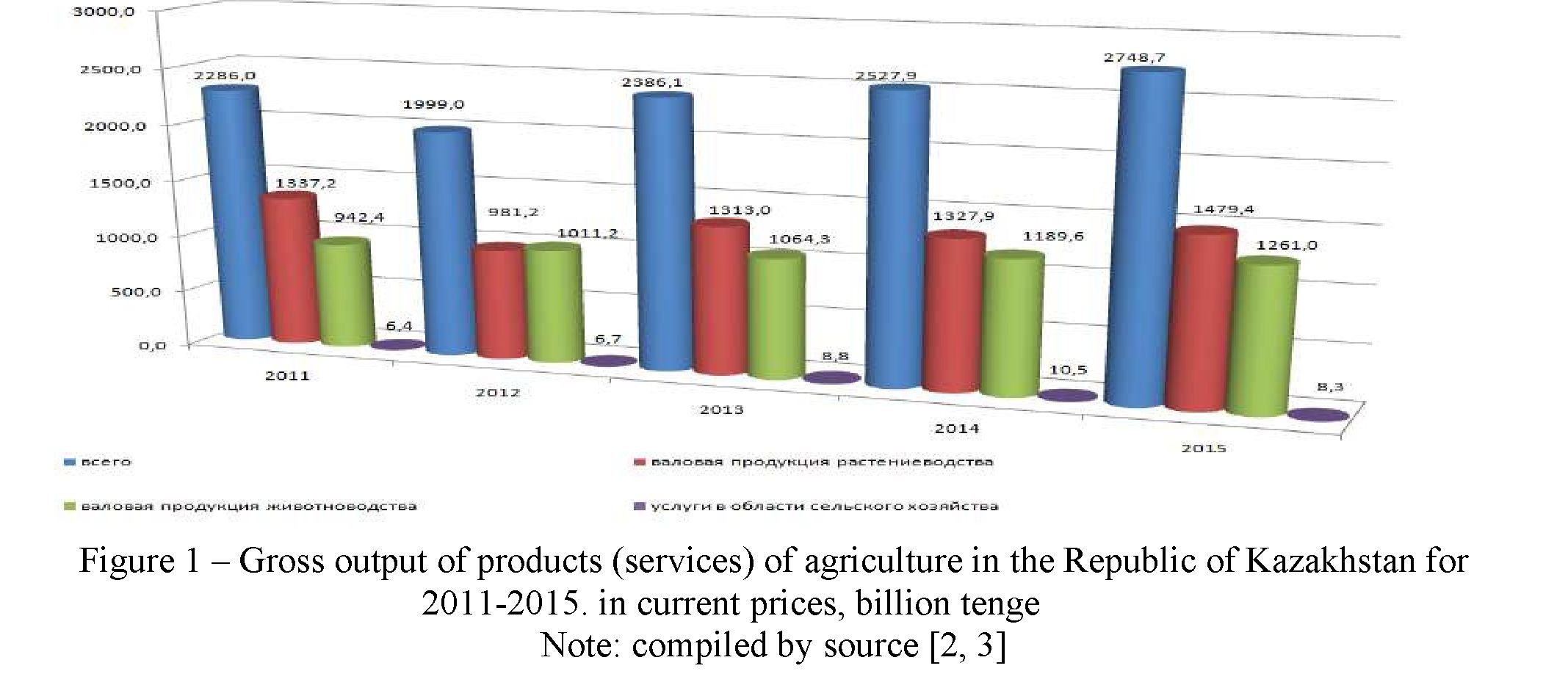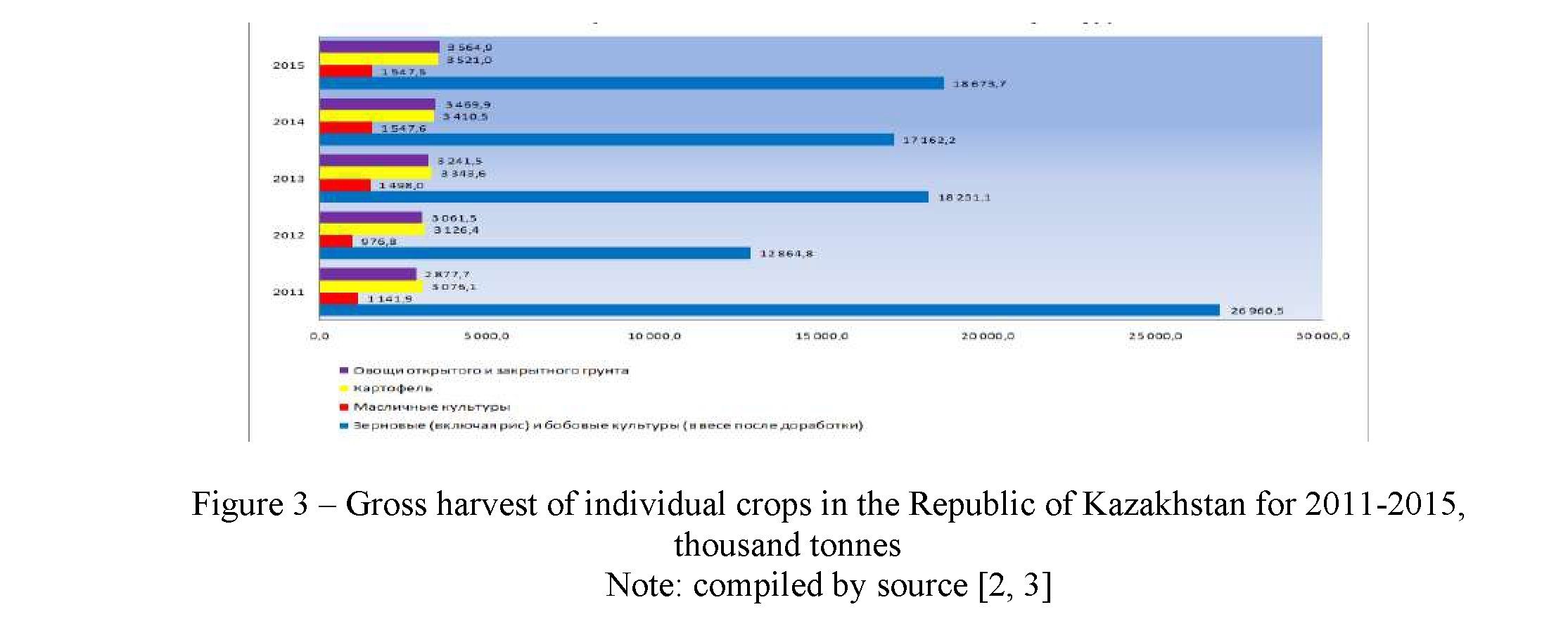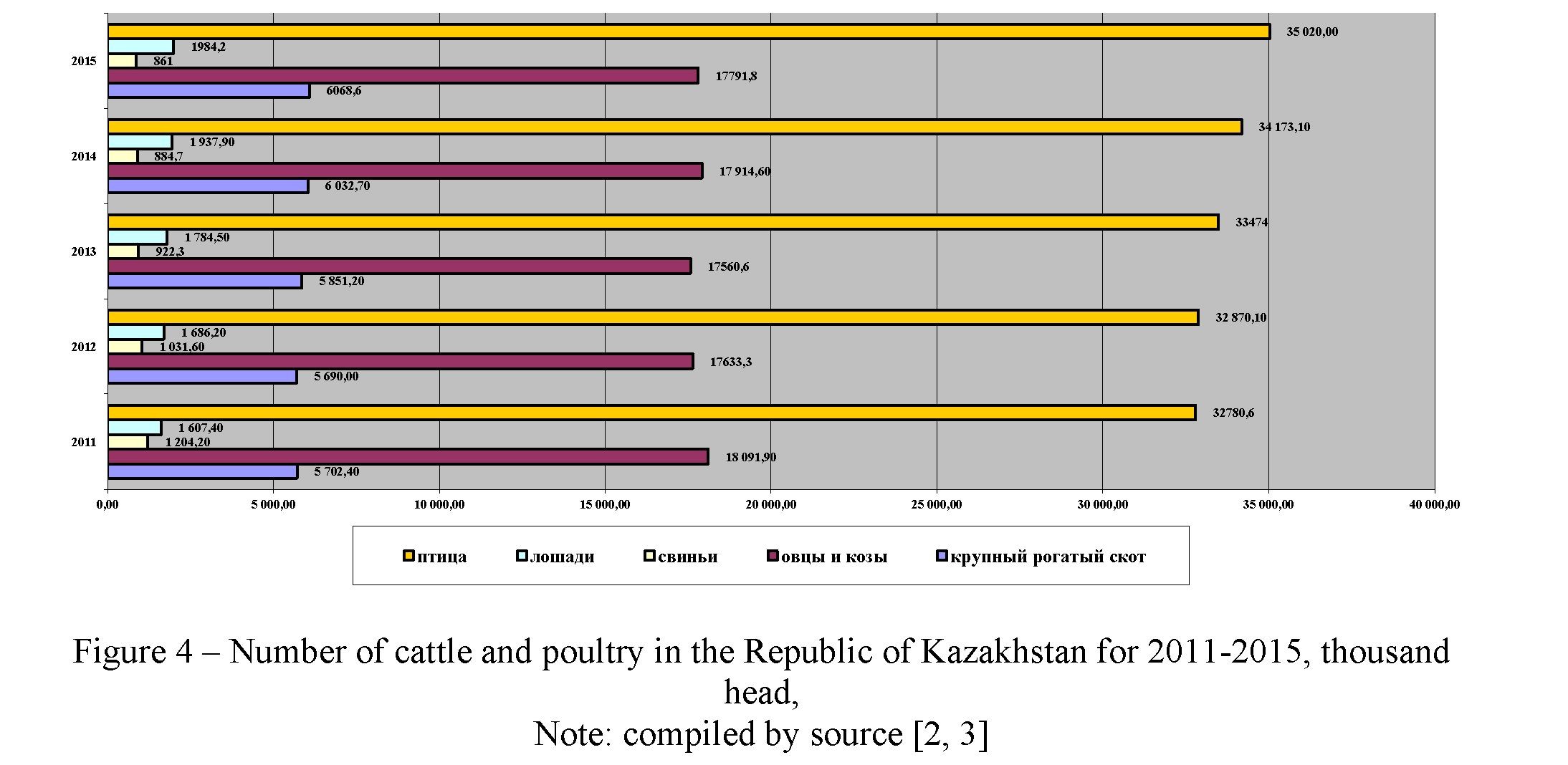Annotation The article analyzes the current state of the agro-industrial complex of the Republic of Kazakhstan.
Since the proclamation of the Independence of the Republic, in the agro-industrial complex, as in the entire economy of the country, significant structural changes has happened. After the abandonment of the centralized planned economy, a set of measures was implemented, aimed at radical reform of the industry.
In general, the political outcome of the reform was the transformation of state property into a private one, as well as the creation of a legal basis for a market economy. Economic consequences were changes in production and land relations, liberalization of pricing, credit system, creation of a competitive market infrastructure. Further development of agricultural production was associated with the definition of the role of the state in supporting this branch of the economy.
The agro-industrial complex, along with industry, energy and services, is a fundamental branch for the economy of any state.
The agro-industrial complex of the Republic of Kazakhstan consists of three interrelated production links. The first includes industries that produce means of production, as well as a system of enterprises and departments that carry out the material and technical supply of the agroindustrial complex. The second link is represented by agriculture itself. The third includes the branches that carry out the procurement, storage, processing and marketing of agricultural products [1].
The state of agriculture in the Republic of Kazakhstan can be judged by the main indicators, which are given in Table 1.
Table 1 – Main indicators of agricultural production in the Republic of Kazakhstan for 2010-2015.
|
Indicators |
2010 |
2011 |
2012 |
2013 |
2014 |
2015 |
|
1 |
2 |
3 |
4 |
5 |
6 |
7 |
|
1. Gross output of agricultural products (services) in current prices, billion tenge |
1442, 6 |
2286, 0 |
1999, 1 |
2386, 1 |
2 527,9 |
2748,7 |
|
Including: |
||||||
|
gross crop production |
662,6 |
1337, 2 |
981,2 |
1313, 0 |
1 327,8 |
1479,4 |
|
gross livestock production |
774,1 |
942,4 |
1011, 2 |
1064, 3 |
1 189,6 |
1261,0 |
|
services in the agriculture |
5,9 |
6,4 |
6,7 |
8,8 |
10,5 |
8,3 |
|
2. Indices of the physical volume of gross agricultural products (services), as a percentage of the previous year |
88,3 |
126,8 |
82,2 |
111,7 |
101,0 |
104.4 |
|
from it: |
Continuation of Table 1
|
1 |
2 |
3 |
4 |
5 |
6 |
7 |
|
gross crop production |
77,4 |
158,9 |
72,4 |
120,7 |
98,5 |
105,6 |
|
gross livestock production |
102,6 |
99,6 |
96,2 |
102,4 |
103,9 |
103,2 |
|
services in agriculture |
95,2 |
101,6 |
93,0 |
129,1 |
134,8 |
100,0 |
|
3. Adjusted crop area of agricultural crops, thousand hectares |
21438 ,7 |
21083 ,0 |
21190 ,7 |
21271, 0 |
21244,6 |
21022,9 |
|
From it: |
||||||
|
cereals (including rice) and legumes |
16619 ,1 |
16219, 4 |
16256 ,7 |
15877, 6 |
15 291,5 |
14982,2 |
|
rice, not collapsed |
94,0 |
93,5 |
93,1 |
89,9 |
97,6 |
98,7 |
|
cotton |
137,2 |
160,6 |
147,7 |
140,6 |
127,6 |
99,3 |
|
beet |
11,2 |
18,2 |
11,8 |
2,7 |
1,2 |
9,2 |
|
sunflower seeds |
869,3 |
954,5 |
794,6 |
877,4 |
846,1 |
740,7 |
|
potato |
179,5 |
184,4 |
190,2 |
184,8 |
186,8 |
190,6 |
|
tabaco |
1,6 |
1,2 |
1,2 |
1,2 |
0,5 |
0,6 |
|
vegetables |
120,3 |
128,7 |
128,7 |
133,1 |
137,7 |
139,5 |
|
melons |
63,3 |
67,7 |
81,8 |
82,3 |
89,7 |
90,1 |
|
forage crops |
2 555,6 |
2 484, 3 |
2 517,4 |
2 866,8 |
3 109,9 |
3209.4 |
|
Gross harvest of individual crops, thousand tons |
||||||
|
cereals (including rice) and legumes |
12185 ,2 |
26960, 5 |
12864 ,8 |
18 231,1 |
17 162,2 |
18673,7 |
|
cereals (except rice) and legumes |
11812 ,1 |
26613, 7 |
12514 ,0 |
17 886,8 |
16 785,1 |
17567,5 |
|
rice, not collapsed |
373,1 |
346,8 |
350,8 |
344,3 |
377,0 |
381,0 |
|
cotton |
239,8 |
336,0 |
379,7 |
396,7 |
320,7 |
340,0 |
|
beet |
152,0 |
200,4 |
151,6 |
64,6 |
23,9 |
174,1 |
|
sunflower seeds |
328,9 |
409,1 |
400,3 |
572,7 |
512,7 |
534,0 |
|
potato |
2 554,6 |
3 076,1 |
3 126,4 |
3 343,6 |
3 410,5 |
3521,0 |
|
tabaco |
3,2 |
2,8 |
2,8 |
2,7 |
1,6 |
1,5 |
|
vegetables |
2 576,9 |
2 877,7 |
3 061,5 |
3241, 5 |
3 469,9 |
3564,9 |
|
melons |
1 118,2 |
1 248,0 |
1 649,9 |
1712, 9 |
1 927,9 |
2087,6 |
|
grape |
56,4 |
57,1 |
71,7 |
68,0 |
70,3 |
71,1 |
|
seed and stone fetus |
147,8 |
157,9 |
185,0 |
192,3 |
210,7 |
222,1 |
|
berries and other fetus |
16,8 |
18,3 |
19,4 |
20,1 |
20,1 |
20, |
|
nuts |
1,2 |
1,7 |
2,3 |
2,3 |
2,2 |
2,3 |
|
Yield of individual crops, c / ha |
||||||
|
cereals (including rice) and legumes |
8,0 |
16,9 |
8,6 |
11,6 |
11,7 |
12,7 |
|
cereals (except rice) and legumes |
7,8 |
16,7 |
8,4 |
11,5 |
11,5 |
12,5 |
|
rice, not collapsed |
39,7 |
37,2 |
37,7 |
38,5 |
39,6 |
|
|
cotton |
17,9 |
21,8 |
26,2 |
28,7 |
25,1 |
27,8 |
|
beet |
174,3 |
188,2 |
168,2 |
267,7 |
240,6 |
232,5 |
|
sunflower seeds |
4,4 |
4,6 |
5,9 |
7,0 |
6,7 |
7,6 |
|
potato |
143,0 |
167,2 |
165,9 |
181,5 |
184,3 |
185,5 |

|
tabaco |
20,2 |
22,5 |
21,8 |
22,6 |
29,6 |
30,0 |
|
vegetables |
214,4 |
222,9 |
234,0 |
238,7 |
243,0 |
245,8 |
|
melons |
177,0 |
186,1 |
206,8 |
212,4 |
217,1 |
221,0 |
|
Number of cattle and poultry, thousand head |
||||||
|
cattle |
6 175,3 |
5 702,4 |
5 690,0 |
5 851,2 |
6 032,7 |
6068,6 |
|
sheep and goats |
17988 ,1 |
18091, 9 |
17633 ,3 |
17560, 6 |
17 914, 6 |
17791,8 |
|
pigs |
1 344,0 |
1 204,2 |
1 031,6 |
922,3 |
884,7 |
861,0 |
|
horses |
1 528,3 |
1 607,4 |
1 686,2 |
1 784,5 |
1 937,9 |
1984,2 |
|
camels |
169,6 |
173,2 |
164,8 |
160,9 |
165,9 |
169,5 |
|
poultry |
32780 ,6 |
32870, 1 |
33474 ,0 |
34 173, 1 |
35 020, 0 |
36635,3 |
|
Production of selected types of livestock products |
||||||
|
slaughtered on the farm or sold for slaughter cattle and poultry (live weight), thousand tons |
1501, 2 |
1511, 5 |
1509, 4 |
1548, 7 |
1602,5 |
1650, 4 |
|
milk, thousand tons |
5 381,2 |
5 232,5 |
4 851,6 |
4 930,3 |
5 067,9 |
5141,3 |
|
eggs, million pieces |
3 720,3 |
3 718,5 |
3 673,4 |
3 896,0 |
4 291,2 |
4719,4 |
|
wool, thousand tons |
37,6 |
38,5 |
38,4 |
37,6 |
37,8 |
38,0 |
|
astrakhan, thousand pieces |
49,4 |
42,0 |
43,6 |
24,3 |
20,1 |
20,1 |
|
Note: the source [2, 3] |
||||||
Analyzing some of the data in Table 1, the following can be noted: gross output of agricultural products (services) in current prices, KZT billion for the analyzed period – 2010-2015, has a growth trend in the whole in the country, for example, in 2015 it was 2748,7 billion tenge, which is 8,7% higher than the level of the previous year 2014. In particular, the share of gross crop production is 53,8% (KZT 1479,4 bln), the share of gross livestock production is 45,9% (KZT 1261,0 bln) and the share of the service in agriculture is 0,3% (8,3 billion tenge). We can see more clearly in Figure 1.
The indices of the physical volume of gross agricultural products (services), as a percentage of the previous year, are shown in Figure 2.
We can note from Figure 2 that during the analyzed period the index of the physical volume of the total livestock production had an even trend, the index of the physical volume of services in the field of agriculture for the period analyzed (2011-2015) fluctuated, the greatest value was for 2014 – 134,8% , so this year they amounted to 1189,6 billion tenge.
Kazakhstan is the largest grain country. In the grain-growing regions, mainly strong and hard wheat varieties with a high gluten content are cultivated, this wheat has a great demand on the world market. The crops of cereals, in general, occupy an area of eighteen million hectares, of which twelve million hectares are allocated for wheat, the gross harvest of which is six hundred thousand tons.
The experience gained in the cultivation of corn, provides a yield of eighty centners per hectare. In Kazakhstan, rice, buckwheat, rapeseed, soybeans, oats, cotton, sugar beet, many vegetables and fruits are also cultivated. The adjusted crop area of agricultural crops, thousand hectares for the analyzed period 2011-2015, indicates that the largest crop area of crops falls on cereals (including rice) and legumes, then oil crops, potatoes, open ground vegetables.
Accordingly, the gross harvest of individual crops, thousands of tons for the analyzed period is shown in Figure 3.
We can see from Figure 3, there is a decline in production of major cereals from 26960,5 in 2011 to 18673,7 in 2015, or 30,8%. Slightly increased collection of oil crops, potatoes and vegetables.

 18
18
In 2011, the crop area of all crops amounted to 21,2 million hectares, of which 16,2 million hectares were grains, including. wheat – 13,8 million hectares. Oilseeds were sown on an area of 1,8 million hectares, cotton – by 160,6 thousand hectares, sugar beet – by 21,0 thousand hectares, potatoes and vegetables and melons, respectively, by 184,2 and 196,5 thousand hectares [2,3]. As a result of a record grain yield indicator (17 centners per hectare) in 2011, 27 million tons of grain were harvested in net weight.
Thus, the volume of production of vegetable and tobacco crops in the republic exceeds the demand of the population in accordance with the national consumption rate by 2,1 times. However, due to the natural and climatic conditions of Kazakhstan, the production and sale of vegetables on a large part of the country's territory are clearly seasonal. In this connection, the issue of providing the population with early vegetables is acute.
The traditional branch of agriculture in Kazakhstan is livestock, it provides the population with food, and light industry with raw materials. Annually, the country produces up to seven hundred and fifty thousand tons of meat, more than four and a half million tons of milk, about two and a half billion eggs, and three thousand tons of wool.
The natural conditions of Kazakhstan, their diversity give rise to significant potential for the development of livestock. Traditionally in Kazakhstan are engaged in sheep breeding, horse breeding, camel breeding, breeding of cattle. Kazakhstan already provides 80% of its own food needs.
The total number of cattle and poultry in the Republic of Kazakhstan for the analyzed period, thousand heads is shown in Figure 4.
We can see in Figure 6, among the main livestock species (excluding birds) in the Republic of Kazakhstan for 2011-2015, the largest number is occupied by sheep and goats, then cattle, horses, pigs. In 2015, the number of cattle was 6068.6 thousand heads, which is 0,6% higher than the previous 2014; sheep and goats amounted to 17791,8 thousand heads, which is 0,7% less than in 2014; the number of horses in 2015 was 1984,2 thousand heads, 2,4% more than in 2014; The number of pigs in 2015 compared to 2014 decreased by 2,7% and amounted to 861 thousand heads. As for birds, for the analyzed years 2011-2015 there is a tendency for growth..
Thus, from the above analysis of the AIC in the Republic of Kazakhstan, it follows that a larger volume of the gross product is one of the priority sectors: crop production, namely, grain farming; and livestock.
 19
19
Further development of the AIC of Kazakhstan should focus on increasing the competitiveness of agricultural products by increasing the effectiveness of state support and creating equal favorable conditions for the development of agribusiness.
- On the approval of the Program for the Development of the Agro-Industrial Complex in the Republic of Kazakhstan for 2013-2020 "Agrobusiness 2020". - Resolution of the Government of the Republic of Kazakhstan No. 151 of February 18, 2013.
- Committee on Statistics of the Ministry of National Economy of the Republic of Kazakhstan: http://stat.gov.kz
- "Kazakhstan in 2014" Statistical Yearbook, Astana 2015 / http://www.stat.gov.kz